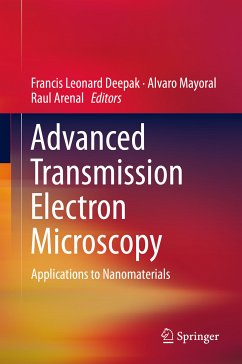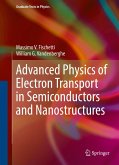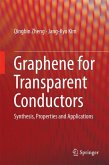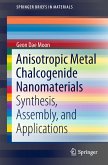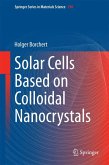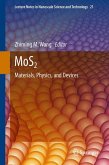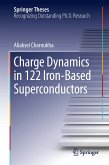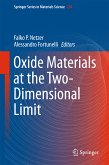Advanced Transmission Electron Microscopy (eBook, PDF)
Applications to Nanomaterials
Redaktion: Deepak, Francis Leonard; Arenal, Raul; Mayoral, Alvaro
73,95 €
73,95 €
inkl. MwSt.
Sofort per Download lieferbar

37 °P sammeln
73,95 €
Als Download kaufen

73,95 €
inkl. MwSt.
Sofort per Download lieferbar

37 °P sammeln
Jetzt verschenken
Alle Infos zum eBook verschenken
73,95 €
inkl. MwSt.
Sofort per Download lieferbar
Alle Infos zum eBook verschenken

37 °P sammeln
Advanced Transmission Electron Microscopy (eBook, PDF)
Applications to Nanomaterials
Redaktion: Deepak, Francis Leonard; Arenal, Raul; Mayoral, Alvaro
- Format: PDF
- Merkliste
- Auf die Merkliste
- Bewerten Bewerten
- Teilen
- Produkt teilen
- Produkterinnerung
- Produkterinnerung

Bitte loggen Sie sich zunächst in Ihr Kundenkonto ein oder registrieren Sie sich bei
bücher.de, um das eBook-Abo tolino select nutzen zu können.
Hier können Sie sich einloggen
Hier können Sie sich einloggen
Sie sind bereits eingeloggt. Klicken Sie auf 2. tolino select Abo, um fortzufahren.

Bitte loggen Sie sich zunächst in Ihr Kundenkonto ein oder registrieren Sie sich bei bücher.de, um das eBook-Abo tolino select nutzen zu können.
This book highlights the current understanding of materials in the context of new and continuously emerging techniques in the field of electron microscopy. The authors present applications of electron microscopic techniques in characterizing various well-known & new nanomaterials. The applications described include both inorganic nanomaterials as well as organic nanomaterials.
- Geräte: PC
- ohne Kopierschutz
- eBook Hilfe
- Größe: 12.95MB
Andere Kunden interessierten sich auch für
![Advanced Physics of Electron Transport in Semiconductors and Nanostructures (eBook, PDF) Advanced Physics of Electron Transport in Semiconductors and Nanostructures (eBook, PDF)]() Massimo V. FischettiAdvanced Physics of Electron Transport in Semiconductors and Nanostructures (eBook, PDF)69,95 €
Massimo V. FischettiAdvanced Physics of Electron Transport in Semiconductors and Nanostructures (eBook, PDF)69,95 €![Graphene for Transparent Conductors (eBook, PDF) Graphene for Transparent Conductors (eBook, PDF)]() Qingbin ZhengGraphene for Transparent Conductors (eBook, PDF)40,95 €
Qingbin ZhengGraphene for Transparent Conductors (eBook, PDF)40,95 €![Anisotropic Metal Chalcogenide Nanomaterials (eBook, PDF) Anisotropic Metal Chalcogenide Nanomaterials (eBook, PDF)]() Geon Dae MoonAnisotropic Metal Chalcogenide Nanomaterials (eBook, PDF)40,95 €
Geon Dae MoonAnisotropic Metal Chalcogenide Nanomaterials (eBook, PDF)40,95 €![Solar Cells Based on Colloidal Nanocrystals (eBook, PDF) Solar Cells Based on Colloidal Nanocrystals (eBook, PDF)]() Holger BorchertSolar Cells Based on Colloidal Nanocrystals (eBook, PDF)73,95 €
Holger BorchertSolar Cells Based on Colloidal Nanocrystals (eBook, PDF)73,95 €![MoS2 (eBook, PDF) MoS2 (eBook, PDF)]() MoS2 (eBook, PDF)121,95 €
MoS2 (eBook, PDF)121,95 €![Charge Dynamics in 122 Iron-Based Superconductors (eBook, PDF) Charge Dynamics in 122 Iron-Based Superconductors (eBook, PDF)]() Aliaksei CharnukhaCharge Dynamics in 122 Iron-Based Superconductors (eBook, PDF)73,95 €
Aliaksei CharnukhaCharge Dynamics in 122 Iron-Based Superconductors (eBook, PDF)73,95 €![Oxide Materials at the Two-Dimensional Limit (eBook, PDF) Oxide Materials at the Two-Dimensional Limit (eBook, PDF)]() Oxide Materials at the Two-Dimensional Limit (eBook, PDF)73,95 €
Oxide Materials at the Two-Dimensional Limit (eBook, PDF)73,95 €-
-
-
This book highlights the current understanding of materials in the context of new and continuously emerging techniques in the field of electron microscopy. The authors present applications of electron microscopic techniques in characterizing various well-known & new nanomaterials. The applications described include both inorganic nanomaterials as well as organic nanomaterials.
Dieser Download kann aus rechtlichen Gründen nur mit Rechnungsadresse in A, B, BG, CY, CZ, D, DK, EW, E, FIN, F, GR, HR, H, IRL, I, LT, L, LR, M, NL, PL, P, R, S, SLO, SK ausgeliefert werden.
Produktdetails
- Produktdetails
- Verlag: Springer International Publishing
- Seitenzahl: 272
- Erscheinungstermin: 5. Juni 2015
- Englisch
- ISBN-13: 9783319151779
- Artikelnr.: 43791883
- Verlag: Springer International Publishing
- Seitenzahl: 272
- Erscheinungstermin: 5. Juni 2015
- Englisch
- ISBN-13: 9783319151779
- Artikelnr.: 43791883
- Herstellerkennzeichnung Die Herstellerinformationen sind derzeit nicht verfügbar.
Dr. Francis Leonard Deepak Francis Leonard Deepak received his PhD in 2005 from Jawaharlal Nehru Centre for Advanced Scientific Research, Bangalore, India. Subsequently he was a postdoctoral fellow (2006-2008) at the Weizmann Institute of Science, Israel. He joined the International Iberian Nanotechnology Laboratory (INL) Braga, Portugal in 2009 as a research fellow. Since 2013 he is a Staff Researcher and currently leads the Advanced Electron Microscopy Group at INL. His broad area of research is focused on the use of advanced electron microscopic techniques (Aberration Corrected TEM/STEM, Analytical Electron Microscopyand Electron Diffraction) in the investigation of materials/nanomaterials for catalytic as well as other applications. He also employs the Focused Ion Beam (FIB) technique extensivelyinthe investigations of nanodevices. Dr. Alvaro Mayoral Alvaro Mayoral obtained his degree in Chemistry by the University of Alcala (Spain) in 2003, he was awarded with the PhD title by the University of Birmingham in 2009 studying the production of metal nanowires from different porous structures such as zeolites and ordered mesoporous structures. Afterwards, he moved to the University of Texas at San Antonio where he worked with Prof. Miguel Yacaman on the synthesis and characterization of noble metal nanoparticles for applications in catalysis and cancer treatment. Since June 2010, Dr. Mayoral belongs to the Advanced Microscopy Laboratory within the Nanoscience Institute of Aragon at the University of Zaragoza. His research is now mainly focused on the observation of nanocatalysts under the electron microscope and theapplication of the most advanced techniques into the observation of beam sensitive materials. Dr. Raul Arenal Dr. Raul Arenal received his Ph.D. in Solid State Physics from Univ. Paris-Sud (Orsay, France, 2005) and in 2013, he obtained his Habilitation (HDR) also at this University. In 2007, he became research scientist (chargé de recherches) at the CNRS (France), working at the LEM, CNRS-ONERA (Chatillon, France). Since 2012, Dr. Arenal is on leave from the CNRS and he is currently ARAID research scientist at the LMA - INA of the Universidad de Zaragoza (Spain). His broad area of research interest lies in electron microscopy focused on materials science and nanoscience: TEM (HR(S)TEM, electron diffraction, EELS), as well as in Raman spectroscopy.These studies are mainly focused on the growth mechanism, structural and physical (electronic, optical, vibrational, mechanical) properties of nanomaterials based on carbon, boron and nitrogen as well as other nano-structures.
Preface.- Introduction to TEM, HRTEM and aberration corrected microscopy.- Electron diffraction and crystal orientation phase mapping under scanning transmission electron microscopy.- Advanced Electron Microscopy in the Study of Multi metallic Nanoparticles.- Zeolites and Ordered Mesoporous materials under the electron microscope.- Local TEM spectroscopic studies on carbon- and boron nitride-based nanomaterials.- 3D-nanometric analyses via electron tomography: application to nanomaterials.- In situ TEM of carbon nanotubes.- Physical characterization of nanomaterials in dispersion by transmission electron microscopy in a regulatory framework.
Preface.- Introduction to TEM, HRTEM and aberration corrected microscopy.- Electron diffraction and crystal orientation phase mapping under scanning transmission electron microscopy.- Advanced Electron Microscopy in the Study of Multi metallic Nanoparticles.- Zeolites and Ordered Mesoporous materials under the electron microscope.- Local TEM spectroscopic studies on carbon- and boron nitride-based nanomaterials.- 3D-nanometric analyses via electron tomography: application to nanomaterials.- In situ TEM of carbon nanotubes.- Physical characterization of nanomaterials in dispersion by transmission electron microscopy in a regulatory framework.
